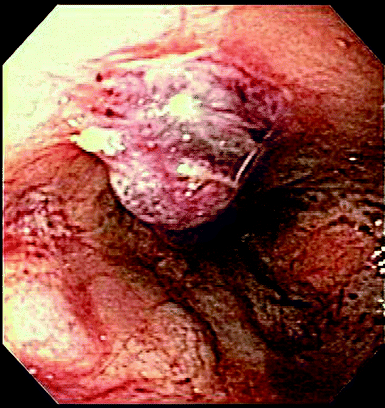Fig. 25.1
Active bleeding from the base of an ulcer. © Dale Dangleben, MD

Fig. 25.2
Blood clot overlying an ulcer. © Dale Dangleben, MD
For bleeding duodenal ulcers, longitudinal duodenotomy should be performed and the ulcer be oversewn with ligation of the gastroduodenal artery if involved. Classically, this is performed with a “U-stich” where sutures (heavy silk) are placed on the proximal, superior, and inferior (3, 6 and 12 o’clock) but not distal borders of the ulcer to avoid potential injury to the ampulla of Vater. If truncal vagotomy is performed, the incision can then be closed as a pyloroplasty. Postoperative treatment for the eradication of H. pylori is essential as rebleeding rates are approximately 7 times higher in those not treated. For gastric ulcers, biopsies should be taken to rule out malignancy and evaluate for H. pylori.
Perforated Ulcers
In selected nonseptic, nonperitoneal patients, nonoperative management is appropriate if perforation is contained without free extravasation of contrast on enhanced imaging. Rapid exploration and repair in the operating room is the cornerstone of treatment for patients who present critically ill with pneumoperitoneum. Even with prompt care, mortality reaches 15%. While the open approach remains the gold standard, laparoscopy has been described for omental patching and vagotomy procedure with good outcomes. Limited studies are available as this continues to be an evolving technique. In patients with profound shock or hemodynamic instability, open repair is required. For most small (<1 cm) duodenal ulcers patching, the defect with omentum without primary closure is satisfactory. Although some surgeons prefer primary closure and omentoplasty, the editors do not favor primary closure given the edema and friability of the ulcer’s edges. The same technique may be used in small gastric ulcers if the suspicion for malignancy is low or if the patient is too unstable to tolerate a more complex repair. Gastric ulcers should always be biopsied intraoperatively. For larger or more suspicious lesions, a distal gastrectomy including the ulcer bed should be performed. Ideally, a Billroth I (antrectomy with gastroduodenostomy) reconstruction is preferred but a Billroth II (antrectomy with gastrojejunostomy) may be required depending on condition of the duodenal stump and the extent of the gastrectomy.
Stay updated, free articles. Join our Telegram channel

Full access? Get Clinical Tree








